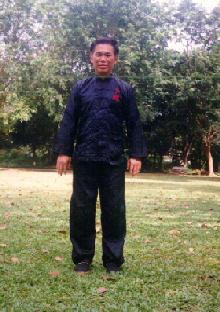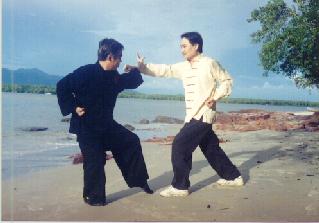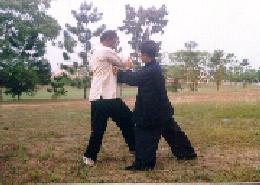December 2005 (Part 1)
SELECTION OF QUESTIONS AND ANSWERS

Sifu Wong in Standing Zen
Question 1
I think I can understand basic Zen philosophy because of your book. To be perfectly honest, I'm not entirely convinced of the truth of Zen philosophy, but it's possible that my belief may strengthen as I practice Zen.
— Lee, USA
Answer
It may be helpful for you, and many people who love to intellectualize like you, to appreciate the crucial differences between studying Zen and practicing Zen. Many people, especially in Western societies, are confused between studying and practicing. They often think that to practice an art, any art, is to study it.
A crucial difference is that studying involves the intellect, whereas practicing involves direct experience. Another difference is that studying involves learning new material, whereas practicing involves going over and over again material that you already have.
For example, if you read about Zen, you study Zen. You may learn from your reading that there are two main traditions of Zen today, namely Soto Zen and Rinzai Zen, or that solving koans or illogical questions is an important part of Zen training. You may also argue, with elaborate examples to substantiate your argument, whether what you have read or studied is right or otherwise.
On the other hand, when you drink tea, you savour the fragrant taste of tea in your mouth, or when you do your daily work you find simple joys in your work (while others may think you crazy), you practice Zen. You may not know what Soto Zen or Rinzai Zen is, or you may not have heard of koans, but you are a Zen practitioner deriving benefits from your practice.
From the perspective of a Zen practitioner, it is not so important whether you are convinced of Zen philosophy or whether your belief will be strengthened. Such issues are the concern of Zen scholars, who may eloquently argue either way. For example, some Zen scholars may argue that Soto Zen is superior to Rinzai Zen, other scholars may argue that Rinzai Zen is superior to Soto Zen, some may argue that both are useless, and others may argue that both are fantastic, and all of them may (or may not) be right in their own reasoning.
To Zen practitioners, whether you are convinced of the truth of Zen philosophy, or whether your belief will be strengthened, is irrelevant. It is irrelevant because they know Zen truths and hold Zen beliefs from their direct personal experience. For example, if they let go of their thoughts and drink their tea, or go about their daily work, they experience fragrant taste in their mouth or simple joys in their work. They experience this not just once or twice, but many, many times.
From the experiences of countless people who practice Zen, Zen masters come to a conclusion that if one lets go of his thoughts when drinking tea or going about his daily work, he will find fragrance in his tea or simple joys in his work. The masters then teach their finding to their students. But the masters do not insist that their findings are absolute truths. They ask their students to find out for themselves and access the teachings to the best of their own understanding and experience. When a lot of people over a long time have found the teachings to be true and beneficial, they become established Zen philosophy and beliefs.
Question 2
As for the idea of me being only a part of the “Universal Mind”, as you put it, and that I am a mind with a physical body, is a little hard to grasp as that goes against the grain of my thinking and what I can observe around me, where I see individual and physical people. But my mind set may change as I practice Zen, so would I be correct in saying that my spiritual roots are above average but not excellent?
Answer
Your spiritual roots are average, which means they are poor, because the great majority of people have poor spiritual roots. Most people, like you, do not realize that they are minds or souls having a physical body. Some believe they are physical bodies which may have a mind or soul. Others do not believe in the existence of souls. They believe what they see physically — individual persons with individual physical bodies and differentiated physical entities like tables and mountains, cars and elephants.
When a Zen practitioner changes his belief, like changing from a belief that we are just physical bodies to a belief that we are minds, the change is not effected by thinking or reasoning, but by direct experience. Many students in Shaolin Wahnam believe in mind because they actually experienced that their mind or spirit expands beyond their physical body. They believe that mind or spiritual expansion leads to joy, peace and freedom, not just because I have told them or they have read about it in books, but they actually experienced tremendous joy, peace and freedom as their mind or spirit expanded, not just once but many times.
Question 3
How do you know when you have attained a one-pointed mind?
Answer
It is like asking how you know you have satisfied your hunger or you have attained a peaceful state. You know from direct experience. If you are in doubt, you have not attained a one-pointed mind.
You can also tell from circumstantial evidence. When you have satisfied your hunger, you would not want to eat more. When you have attained a peaceful state, you would not be shouting in anger or crying in grief. When you have attained a one-pointed mind, you can think clearly, are relaxed and fresh, can work for a long time physically as well as mentally without feeling fatigue, and produce better result in whatever you do.

In kungfu one should not be physically or mentally tensed even in combat
Question 4
When you were talking about a one-pointed mind, did you mean that Theravada state of bliss or merely having a clear mind?
Answer
A one-pointed mind is a one-pointed mind. There is no play of words and also you should not read meaning into it when it is not there.
A one-pointed mind may or may not be applied to a Theravada state of mind, and it may or may not be merely having a clear mind. In other words, when you are in a Theravada state of mind, you may have a one-pointed mind. When you are in a Christian or Hindu state of mind, you also may have a one-pointed mind.
When you have a one-pointed mind, you may merely have a clear mind and nothing else, or you may have a clear mind as well as being focused on a question, or you may have intrinsic energy surging inside you, or you may have some chocolate inside your stomach, or many other things too. What is certain is that you have a one-pointed mind, not a distorted mind or a troubled mind or a wandering mind.
Just as when you say John is English, it means John is English. He may or may not have some Irish or Japanese blood in him, he may live in England or India, he may like Chinese food and dislike playing soccer, and many things else. What we are sure is that John is English, not Indian, Irish or Japanese.
Question 5
How do you “let your mind expand”?
Answer
It is like asking how you walk. You just walk. Similarly you just let your mind expand. Of course you have to learn the necessary skills to do so, just as you had to spend about a year learning the necessary skills to walk.
Question 6
What books on Buddhism and/or Zen would you recommend to me?
Answer
I would recommend “The Complete Book of Zen” and “The Complete Book of Shaolin”. It so happens that both books were written by me.

As a general rule the knee should not be bent beyond the toes, otherwise it may cause knee injury
Question 7
I am currently experiencing strange difficulties whilst practising Kung Fu, and given your great knowledge, I am hopeful that you will be able to assist me in these matters.
I have been practising freestyle Karate and kickboxing from a renowned local master for the last 5 years, and for the last 2 years have been attempting to learn Kung Fu (only set practice and force training) from the highly informative books that you have written. Occasionally (for the last few months) when I have performed a set such as the Shaolin Five Animals or the Dragon Tiger set, I have found myself with slight abdominal pains, shortness of breath, and sudden bouts of fatigue.
I have ceased training immediately and rested, and after half an hour or so I feel much better. Both myself and my father are worried that I might be inadvertently misdirecting my chi, thus producing my symptoms. Any advice or training suggestions that you might be able to offer would be most welcome.
— Harry, England
Answer
The most common cause of wrong training that brings harmful side-effects is muscular tension. As you only train kungfu sets and not internal force, the harm would not be so serious, but still there may be harm if you are tensed while training. This appears to be your case. Muscular tension results in energy blockage with symptoms like what you experienced, such as bodily pain, shortness of breath and fatigue.
But don't worry. Your side effects can be rectified. You are wise to stop training, at least for the time being. Now you should perform some remedial exercise. One of the best is “Lifting the Sky”, which you can read from any of my books.
I have mentioned it in my instructions, but I would emphasize it for you. You must be totally relaxed when performing “Lifting the Sky” as a remedial exercise. Do not tense any muscles. This may not be as easy as it appears for those who have been practicing Karate, Taekwondo or Kick Boxing for some years.
From my many years of teaching students with external martial art experience, I have found that relaxing is actually the instruction they have most difficulty in fulfilling. They honestly thought they were relaxed when they were tensed! Remember that if you wish to benefit from chi kung, especially as a remedial exercise, you must be relaxed when performing the exercise. Chi kung is very different from Karate; the more relaxed you are, the more benefits you will derive from it.
Perform “Lifting the Sky” about 20 times. Remember not to tense any muscles. For your purpose of overcoming energy blockage, breathe in gently, and breathe out loudly but in a relaxed manner. Open your mouth quite wide as you breathe out. Breathing out is actually an important part of clearing the bad chi that has caused you blockage.
After about 20 repetitions, stand upright and be relaxed. Close your eyes if you have not already closed them. Do not do anything nor think of anything. If you have performed the exercise correctly, and if you are relaxed enough, you may soon find your body swaying.
Your body sway is the result of your internal chi flow. The chi flow can move your body because you are relaxed. If you tense your muscles, you will stop the flow, as well as stop the benefit that you will derive from the remedial exercise. Your chi flow may pick up momentum and you may be moving vigorously, including moving your hands or moving from your standing position. But if the movement becomes too vigorous, tell your body to slow down. You may also feel some pain. This is what we call “good pain”. It is a sign that your chi flow is taking good effect on you, and clearing your blockage.
After about 10 minutes of chi flow, slow down, then come to a graceful stop. Remain still for some time. Next, rub your palms together and then warm your eyes with your palms. Massage your face and walk about for about 20 steps. This completes the exercise. Practice twice a day, once in the morning and once in the evening or at night. Each session takes about 15 to 20 minutes. You should recover in about 3 to 6 months. Continue to practice this wonderful exercise, and you may find that you have better health and more vitality than you ever had before.
Question 8
I have been practicing Taiji for a few months and have developed sore knees. Is this routine, or am I practicing incorrectly? Any advice as to why my knees are sore?
— Kama, Indonesia
Answer
Developing sore knees from Taiji or any martial art practice is certainly not routine. If you have practiced correctly, your knees should be stronger, not weaker, than before. You have practiced wrongly.
A likely cause of your wrong practice is that you bend your knees too far forward. As a general rule, your knees should not be bent beyond your toes. If you do so you would cause energy to flow to your knees but become locked up there. It is not difficult to see this fault diagrammatically. Draw a picture of a person at a very low Bow-Arrow Stance with his front knee protruding beyond his front toes.
You can easily see from the picture that chi flowing from his body to the ground would be locked at the front knee. If he does this once a while, the energy blockage may not be serious. But if he does this 30 to 50 times a day, everyday for a few months, the harm can be substantial.
Another possible cause of your sore knees is that you bend your knees along the straight line of your upper and lower leg bones. This is what some Western anatomists and physical exercise instructors advise. I suspect that in this case these experts speak from theoretical knowledge and not from direct experience. They reason from theoretical knowledge that bending the knees linearly according to the alignment of the knee joints would cause the least friction, and therefore the least injury.
But direct experience shows otherwise, and again it is not difficult to find it out yourself. Go into a Bow-Arrow Stance by bending your front knee linearly about 10 to 20 times. Now compare the bending movement the way those who speak from direct experience, i.e. the traditional Taijiquan masters, advise. The masters advise that you rotate your knees.
Your sore knee problem can be overcome by practicing the following chi kung exercise. Interestingly this exercise is called “Rotating Knees”, as that is what it involves.
Rub your palms to warm them, and then place your warm palms on your knees, and rotate the knees about 20 to 30 times one side, then 20 to 30 times the other side. Then stand upright, drop your hands at your sides, and let go. “Let go” means let go. It means you do not consciously do anything physically and mentally. You do not, for example, tense your muscles, and you do not think of any thoughts. Just let go for about 5 to 10 minutes, then complete the exercise by gently thinking of your dan tian (abdominal energy field).
If you have practiced this exercise correctly for some time, you would have generated an energy flow. And if you are relaxed enough, this energy flow inside your body may move you externally. Go along with the energy flow. However, if the movement becomes too vigorous, slow it down.
LINKS
Selected Reading
- Carry Tiger Back to Mountain
- The Legacy of Shaolin Wahnam — Sifu Anthony Korahais
- Experiencing Satori at Intensive Shaolin Kungfu Course — Joshua Lawson
- What is Wahnam Taijiquan
- Wahnam Taijiquan Sets in Slow Motion
- Counters against Wrestling
